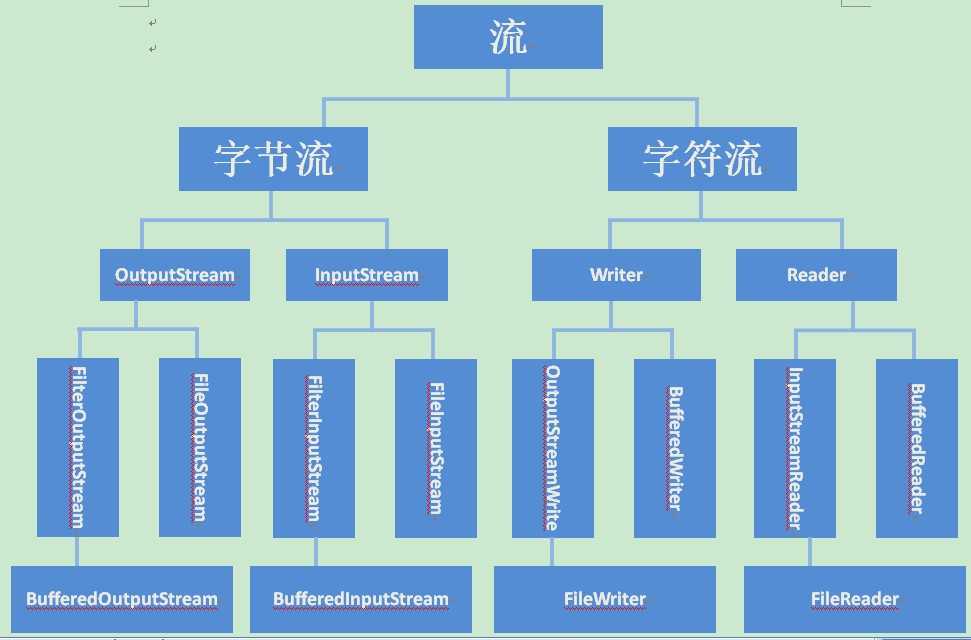标签:
对于任何程序设计语言而言,输入输出(I/O)系统都是比较复杂的而且还是比较核心的。在java.io.包中提供了相关的API.
流的方向:
处理数据单元:
功能不同
Jdk提供的流继承了四大类:InputStream(字节输入流),OutputStream(字节输出流),Reader(字符输入流),Writer(字符输出流)。
以下是java中io中常用的流。

InputStream
抽象类java.io.InputStream是所有字节输入流类型的父类,该类中定义了以字节为单位读取数据的基本方法,并在其子类中进行了分化和实现.
三个基本的read方法:
其他方法:
InputStream类层次

import java.io.File ;
import java.io.InputStream ;
import java.io.FileInputStream ;
public class InputStreamDemo{
public static void main(String args[]) throws Exception{ // 异常抛出,不处理
// 第1步、使用File类找到一个文件
File f= new File("d:" + File.separator + "test.txt") ; // 声明File对象
// 第2步、通过子类实例化父类对象
InputStream input = null ; // 准备好一个输入的对象
input = new FileInputStream(f) ; // 通过对象多态性,进行实例化
// 第3步、进行读操作
byte b[] = new byte[1024] ; // 数组大小由文件决定
int len = 0 ;
int temp = 0 ; // 接收每一个读取进来的数据
while((temp=input.read())!=-1){
// 表示还有内容,文件没有读完
b[len] = (byte)temp ;
len++ ;
}
// 第4步、关闭输出流
input.close() ; // 关闭输出流 System.out.println("内容为:" + new String(b,0,len)) ; // 把byte数组变为字符串输出
}
};
OutputStream
java.io.OutputStream与java.io.InputStream对应,是所有字节输出流类型的抽象父类。
三个基本的write方法:
其他方法:
OutputStream类层次

import java.io.File ;
import java.io.OutputStream ;
import java.io.FileOutputStream ;
public class OutputStreamDemo{
public static void main(String args[]) throws Exception{ // 异常抛出,不处理
// 第1步、使用File类找到一个文件
File f= new File("d:" + File.separator + "test.txt") ; // 声明File对象
// 第2步、通过子类实例化父类对象
OutputStream out = null ; // 准备好一个输出的对象
out = new FileOutputStream(f) ; // 实例化
// 第3步、进行写操作
String str = "Hello World!!!" ; // 准备一个字符串
byte b[] = str.getBytes() ; // 只能输出byte数组,所以将字符串变为byte数组
out.write(b) ; // 写入数据
// 第4步、关闭输出流
// out.close() ; // 关闭输出流
}
};
Reader
抽象类java.io.Reader是所有字符输入流类型的父类,其中声明了用于读取字符流的有关方法.
三个基本的read方法:
其他方法:
Reader类层次

import java.io.File ;
import java.io.Reader ;
import java.io.FileReader ;
public class ReaderDemo{
public static void main(String args[]) throws Exception{ // 异常抛出,不处理
// 第1步、使用File类找到一个文件
File f= new File("d:" + File.separator + "test.txt") ; // 声明File对象
// 第2步、通过子类实例化父类对象
Reader input = null ; // 准备好一个输入的对象
input = new FileReader(f) ; // 通过对象多态性,进行实例化
// 第3步、进行读操作
char c[] = new char[1024] ; // 所有的内容都读到此数组之中
int temp = 0 ; // 接收每一个内容
int len = 0 ; // 读取内容
while((temp=input.read())!=-1){
// 如果不是-1就表示还有内容,可以继续读取
c[len] = (char)temp ;
len++ ;
}
// 第4步、关闭输出流
input.close() ; // 关闭输出流
System.out.println("内容为:" + new String(c,0,len)) ; // 把字符数组变为字符串输出
}
};
Writer
java.io.Writer与java.io.Reader类对应,是所有字符输出流类型的共同父类.
五个基本的write方法:
其它方法:
Writer类层次

import java.io.File ;
import java.io.Writer ;
import java.io.FileWriter ;
public class WriterDemo{
public static void main(String args[]) throws Exception{ // 异常抛出,不处理
// 第1步、使用File类找到一个文件
File f= new File("d:" + File.separator + "test.txt") ; // 声明File对象
// 第2步、通过子类实例化父类对象
Writer out = null ; // 准备好一个输出的对象
out = new FileWriter(f) ; // 通过对象多态性,进行实例化
// 第3步、进行写操作
String str = "Hello World!!!" ; // 准备一个字符串
out.write(str) ; // 将内容输出,保存文件
// 第4步、关闭输出流
out.flush() ; // 强制性清空缓冲区中的内容
// out.close() ; // 此时,没有关闭
}
};
拷贝实例:
import java.io.* ;
public class Copy{
public static void main(String args[]){
if(args.length!=2){ // 判断是否是两个参数
System.out.println("输入的参数不正确。") ;
System.out.println("例:java Copy 源文件路径 目标文件路径") ;
System.exit(1) ; // 系统退出
}
File f1 = new File(args[0]) ; // 源文件的File对象
File f2 = new File(args[1]) ; // 目标文件的File对象
if(!f1.exists()){
System.out.println("源文件不存在!") ;
System.exit(1) ;
}
InputStream input = null ; // 准备好输入流对象,读取源文件
OutputStream out = null ; // 准备好输出流对象,写入目标文件
try{
input = new FileInputStream(f1) ;
}catch(FileNotFoundException e){
e.printStackTrace() ;
}
try{
out = new FileOutputStream(f2) ;
}catch(FileNotFoundException e){
e.printStackTrace() ;
}
if(input!=null && out!=null){ // 判断输入或输出是否准备好
int temp = 0 ;
try{
while((temp=input.read())!=-1){ // 开始拷贝
out.write(temp) ; // 边读边写
}
System.out.println("拷贝完成!") ;
}catch(IOException e){
e.printStackTrace() ;
System.out.println("拷贝失败!") ;
}
try{
input.close() ; // 关闭
out.close() ; // 关闭
}catch(IOException e){
e.printStackTrace() ;
}
}
}
}
*** 在一般操作输入输出内容就需要使用字节或字符流,但是有些时候需要将字符流变成字节流的形式,或着将字节流变成字符流的形式,所以就需要另外一组转换流操作类
如果以文件操作为例,则在内存总的字符数据需要通过OutputStreamWriter变成字节流保存在文件中,读取的时候需要将读入的字节流通过InputStreamReader变成字符流

例如,将字节的文件输出流以字符的形式输出
import java.io.* ;
public class OutputStreamWriterDemo{
public static void main(String args[]) throws Exception { // 所有异常抛出
File f = new File("d:" + File.separator + "test.txt") ;
Writer out = null ; // 字符输出流
out = new OutputStreamWriter(new FileOutputStream(f)) ; // 字节流变为字符流
out.write("hello world!!") ; // 使用字符流输出
out.close() ;
}
};
读的时候亦可以使用字符流的形式读取字节流的文件
import java.io.* ;
public class InputStreamReaderDemo01{
public static void main(String args[]) throws Exception{
File f = new File("d:" + File.separator + "test.txt") ;
Reader reader = null ;
reader = new InputStreamReader(new FileInputStream(f)) ; // 将字节流变为字符流
char c[] = new char[1024] ;
int len = reader.read(c) ; // 读取
reader.close() ; // 关闭
System.out.println(new String(c,0,len)) ;
}
};
原文:http://www.cnblogs.com/oumyye/p/4314412.html
标签:
原文地址:http://www.cnblogs.com/onetwo/p/4315030.html